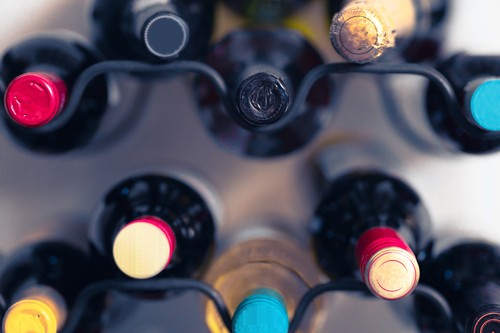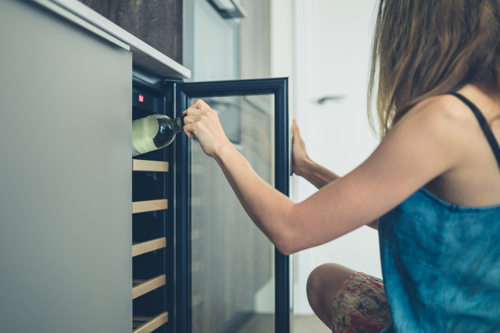So you’ve bought a few bottles of wine that you’re not planning on drinking anytime soon — now what? If you’re like most casual wine enthusiasts, you probably have questions about how long wine lasts or what the best wine storage temperature is. The truth is that you don’t need an expensive setup to keep your bottles in great condition. With a few simple principles, you can actually give your wine the chance to develop deeper textures and flavors over time and really come to life. Read on to learn all you need to know about how to store wine at home, including which wines are suited for aging, proper storage conditions and more.
1. Why Storing Wine Properly Is Important
As wine ages, its flavor, color and aroma will change. This is due to the chemical reactions that are constantly taking place in any given wine. For example, tannins — chemical compounds from grape skins and seeds — change over time so that their original bitter and astringent taste mellows into something pleasant and soft. So whenever you open a new bottle, you’re actually catching it at a specific and unique stage of its development.

Under ideal conditions, red wines turn from purple to reddish, then slightly orange, then finally a dull brown. White wines, on the other hand, start with a green tinge before developing a golden-brown hue. Due to the higher acidity of white wine, it will not brown completely. For this reason, it’s a better candidate for aging.
How Long Is Wine Good For?
You may be wondering whether your wine needs to be aged in order to reach its best flavors and textures. As it turns out, only one to three percent of wine is meant to be aged before consumption — most bottles you can affordably buy are supposed to be drunk within five years of purchase. As a rule of thumb, if your bottle is under 30 dollars, it’s ready to pour. After five years, the quality will begin to deteriorate instead of improve.

2. How to Store Wine
You may already know to keep your wine in a “cool, dark place,” whether you’re letting it age or just waiting for the right occasion to pop the cork. But what exactly does this mean? Here, we’ll cover several factors that affect how to store your wine.
Humidity
Typically, you want to keep the humidity of the space where your wine is stored around 70 percent. This level of humidity will keep the cork from drying out (which would otherwise let air into the bottle and spoil the wine) and minimize loss from evaporation. Anything higher than 70 percent will promote mold growth, and can also damage or loosen the label. While 70 is the sweet spot, anywhere between 50 and 80 percent is considered safe, especially if you have a dehumidifier running. Keeping a pan of water in your storage area can also help maintain the right humidity levels.
Temperature
Much like humidity, there is a sweet spot for wine storage temperature: between 54 and 55 degrees Fahrenheit. Anything in the 45- to the 65-degree range is considered safe, but storing above 70 degrees can accelerate the aging process of the wine (wine begins to oxidize at 75 degrees). Any warmer and you can actually “cook” your wine, leading to flat flavors and aromas.
But keeping your wine at the right temperature is just one factor. It’s equally important to keep the temperature stable, especially for red wines. On a given day, you should make sure that there’s no more than a three-degree fluctuation in temperature or a five-degree fluctuation during a given year. A change in temperature beyond that can actually prematurely age your wine.
Sunlight
Both UV light and artificial light can degrade and rapidly age wine. It’s best to keep wine out of sunlight and turn any other lights off when you aren’t in the storage area. If the wine is in a tinted bottle, it has a bit of protection from your standard light bulb, but you may find that your labels will fade a little more quickly. When it comes to installing a light source in your storage area, opt for incandescent instead of fluorescent to avoid trace amounts of UV.
Position
You want to position your bottles in a way that prevents any sudden movements. Shaking or vibrating a bottle of wine can speed up certain chemical processes, or disturb the natural sediment in older wines, yielding a gritty texture.
If your bottle is corked, turn it sideways to keep the liquid against the cork, which prevents it from drying out. If you’re planning on drinking the wine soon after purchase — or if your bottle comes with a screw-on cap — you don’t need to worry too much about storing it horizontally.

3. Where to Store Your Wines
Depending on the size of your wine collection — and the size of your apartment tor house — you may have to improvise when it comes to a storage area. If you only have a couple of bottles, carve out some space in a dark closet. Though you’ll have very little control over temperature and humidity, you’ll be able to ensure that your bottles are protected from light. If you have a basement, store your wine there: temperatures typically stay fairly low. All you’ll need to purchase is a simple wine rack to get started.
Should You Refrigerate Wine?
If you want more temperature control, look into a reasonably priced wine refrigerator. Committing is a bit of an investment, but you’ll be able to guarantee that your bottles live in a consistent temperature all year round, regardless of the season. And if you’re short on space, or have a large collection, consider placing your wine in a climate-controlled storage unit.
| Interested in the best wine fridges and coolers for both casual wine drinkers and enthusiasts? Check out the 9 Best Wine Coolers and Fridges. |
Finally, if you have a significant collection, or highly valuable bottles, it might be best to look into professional offsite storage. While it will cost you more than any of the other options, it’s also the best way to store wines that may be sensitive to light, humidity or temperature.









